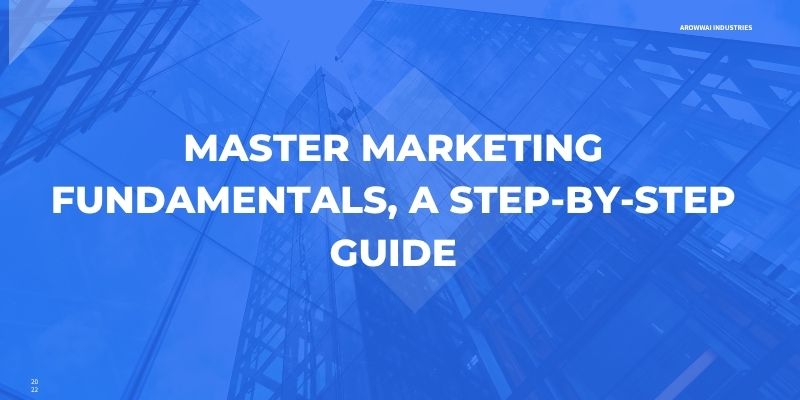Any business that is achieved is anchored by marketing. Regardless of being a startup founder, freelancer or working in a large organisation, learning the Marketing Fundamentals can guide you to develop trust, find the perfect customers and grow sustainably. The most successful global brands did not happen overnight; they implemented the established principles of marketing in phases.
This guide will take you through the marketing fundamentals in a simple, actionable, and easy-to-digest way. You will not only know what, but also the how and will be able to implement strategies immediately.
Why Marketing Fundamentals Matter
The contemporary marketing environment is dynamic with new instruments, platforms and trends emerging almost every day. But the fundamentals never differ. The best tools will not help unless there is a solid base.
This is why the art of the basics is so effective:
- Will allow you to know your audience better.
- It maintains your brand communication.
- It enables you to quantify what really grows.
- Makes you flexible enough to adapt to changes in the trends without compromising on your main strategy.
Imagine that it is driving lessons. The fundamentals of steering, braking, and signalling are never any different, whether it is a small car or a luxury car. The same is true of marketing.
Step 1: Know Your Market and Your Audience.
All successful marketing plans start with research. When you have no idea who you are serving, then you have been shooting in the dark.
Key Actions to Take:
- Market Research: Research the trends, competitors and growth opportunities in your industry. Apply such tools as Google Trends, Statista or reports in the industry.
- Audience Research: Develop a clear image of your buyer personas. Research on their demographics (age, gender, income), psychographics (interests, values, lifestyle) and purchasing habits.
- Pain Points and Needs: Ask- What are the problems that my audience is experiencing that can be solved by my solution?
Example: In the case of eco-friendly packaging, you may want to focus on small business owners in e-commerce who are interested in sustainability and do not want to spend too much.
Step 2: Decision Making: Your Unique Value Proposition (UVP)
In a crowded market, everything is differentiation. Your Unique Value Proposition (UVP) is the obvious reason why one would go with you as opposed to the competitors.
Crafting Your UVP:
- Determine everything different about you (price, quality, speed, experience).
- Associate those variations with benefits to customers.
- Make it short, to the point and customer-oriented.
Example: As opposed to offering, we sell shoes offer We make shoes that are comfortable and are made out of sustainable materials, so that you do not need to decide between style and responsible actions.
Step 3: Develop a Good Brand Identity
Your brand is more than a logo. It is the total experience that people will go through in your business. Clarity of the brand will draw customers who not only identify with your message but also are loyal.
Elements of Brand Identity:
- Rhetoric and Design: Your logo and visual elements are supposed to be in line with your ethics.
- Brand Voice: Does your voice sound professional, friendly, witty, or inspirational? Be regular across all locations- ads, emails, social posts, website.
- Storytelling: Tell about your mission and purpose. Stories are more important to people than facts.
Example: Think about Apple. It not only sells gadgets, it sells innovation, creativity and lifestyle.
Step 4: Learn to Master the Marketing Mix (The 4 Ps)
These are the 4 Ps of marketing, and they are eternal marketing pillars that every marketer ought to learn.
- Product: What is it that you are selling, and how does it solve a problem?
- Price: Determined pricing that is of value yet is suitable for your market segment.
- Place: Determine where, and how the customers locate your product (internet store, brick and mortar stores, markets).
- Promotion: It is possible to promote it using advertising, PR, content marketing, and social media strategies.
Example: Starbucks uses the 4Ps brilliantly, coffee (product), high pricing, convenient stores, and smart digital marketing.
Step 5: Design an effective Marketing Strategy.
Everything is bound together by a strategy. Without it, you would be randomly posting ads or content, and you would be aimlessly doing it.
Elements of An Effective Strategy:
- Goals: This is to define SMART goals (Specific, Measurable, Achievable, Relevant, Time-bound).
- Target Audience: Research helps you narrow down to those people who are the most likely to purchase.
- Messaging: Use your UVP and the needs of your audience to match campaigns.
- Budget: Spend money judiciously, decide on the percentage to be allocated to advertising, search engine optimisation, content, or social media.
Step 6: Take advantage of the Digital Marketing Channels.
Digital marketing will have unparalleled opportunities to connect with your audience. However, not every channel is effective for every business.
Core Channels to Explore:
- Content Marketing: Gain credibility through blogs, videos, case studies and guides.
- Social Media Marketing: Social media such as Instagram, LinkedIn, or TikTok, to raise brand awareness and interact.
- Email Marketing: The emails offer the opportunity to turn leads into paying customers through personalised communication.
- SEO (Search Engine Optimisation): Make sure your website ranks on Google through optimisation of keywords, structure and backlinks.
- Paid Ads: Google Ads or social ads will give you instant visibility.
- Pro Tip: Find out what works best by beginning small and trying various channels first, and then investing more in the one with the highest ROI.
Step 7: Use Data and Analytics
The marvel of contemporary marketing is that nearly anything can be traced. Numbers are the true account of what works and what does not work.
What to Track:
- Traffic to the website and active participation (Google Analytics).
- Social media intelligence (reach, engagement, conversion).
- Opening and click-through rates on emails.
- Paid ad performance (CPS, CPA ROI).
Data is not about reporting: It is about making your next step better. When there are low open rates on emails, revise subject lines. Trying to make ads but not converting, you should reconsider your targeting.
Step 8: Develop Relationships, not Sales.
Customers today are experience seekers and relationship seekers. Tactic marketing is dead; you have to create emotional relationships.
Ways to Build Relationships:
- Be active on social media (answer comments, make polls, publish user-generated content).
- Provide reward systems and loyalty programs.
- Create behind-the-scenes content to help customers feel like part of your experience.
- Deliver an outstanding customer service.
The most powerful marketing tool that you have is customer trust; word-of-mouth is better than any marketing campaign.
Step 9: Adapt, Innovate and Experiment.
There is no eternal marketing strategy. Consumer behaviour changes, trends change, and new platforms come onto the scene. Rigid marketers are abandoned.
Tips to Stay Ahead:
- Keep an eye on industry news.
- Experiment with new formats such as short-form video or virtual events.
- Experiment with new technologies such as AI-personalisation or chatbots.
- Keep on testing your campaigns A/B.
Step 10: Never Stop Learning and Growing.
- Marketing is a lifelong skill. The basics will not change, but plans are always changing.
- Read books and reports (e.g. Principles of Marketing by Kotler).
- Be a follower of digital marketing leaders.
- Do online courses and certifications (Google, HubSpot, LinkedIn Learning).
- Take lessons out of actual campaigns–learn what you do well and what you do poorly.
FAQs
1. Which is the most significant marketing basic?
Knowing your audience. The rest of the efforts will go wrong without the knowledge of what they need.
2. What is the difference between marketing and branding?
Marketing refers to the way in which you advertise your products and get customers. Branding is the name and narrative that causes people to emotionally relate to your business.
3. Does digital marketing differ from traditional marketing?
Yes. The traditional marketing methods involve print, television, or radio, whereas the digital method depends on online platforms, such as SEO, social media platforms, and email. Nevertheless, the basics are identical.
4. What are the indications of whether my marketing strategy is effective or not?
Measure performance indicators such as conversions, ROI, traffic on the site, and interaction with customers. Statistics will show whether your work bears fruit.
5. What is a suitable amount that a small business should spend on marketing?
The average is 7 -10 per cent of revenue, although this is dependent on the industry, objectives, and competition.
Conclusion
Mastering fundamentals is about more than flashy campaigns; it’s about building a deep understanding of your audience, communicating value clearly, and creating long-term relationships. Whether it is researching your market, crafting a UVP, harnessing digital channels, or accommodating change, this step-by-step guide outlines everything you should be doing to stay on top of the competitive environment today. Marketing is not a one-time event. It is an approach that is strategic, consistent and customer-driven and builds up throughout the years.
Also, read our recent article: Apkek org: Review Apps, Online Earning, and Security Guide



